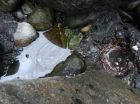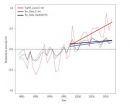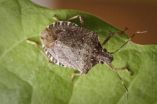(Press-News.org) HONOLULU – Twenty-five years after the infamous Exxon Valdez oil spill in Prince William Sound, beaches on the Alaska Peninsula hundreds of kilometers from the incident still harbor small hidden pockets of surprisingly unchanged oil, according to new research being presented here today.
The focus of the study is to learn how oil persists long after a spill. Researchers presenting the work caution that the amount of oil being studied is a trace of what was originally spilled and that results from these sites cannot be simply extrapolated to the entire spill area.
The rocky, high-energy coastlines in the Shelikof Strait, southwest of the spill, contain small remnants of the spill which appear to be protected by a stable boulder and cobble "armor," says Gail Irvine of the U.S. Geological Survey's Alaska Science Center.
"To have oil there after 23 years is remarkable," said Irvine. "We have these marked boulders whose movement we've been studying for more than 18 years. The oil itself has hardly weathered and is similar to 11-day-old oil."
The oil was positively identified as that from the Exxon Valdez by chemists at the National Oceanic and Atmospheric Administration's Auke Bay Laboratory and in Christopher Reddy's lab at Woods Hole Oceanographic Institution, which specializes in investigating oil spills of all kinds – particularly those which are decades old.
"Very old oil spills can be found to still have oil," said Reddy. "We were capable of fingerprinting that oil."
The new findings from this study - about where oil can persist and which chemical compounds in the oil are more and less durable - offer some "silver linings" to the disastrous spill, said Reddy. The researchers are presenting the new research today at the 2014 Ocean Sciences Meeting co-sponsored by the Association for the Sciences of Limnology and Oceanography, The Oceanography Society and the American Geophysical Union.
"One lesson is that if you are responsible for cleaning up a spill, you want to be proactive about cleanup behind the boulders," said Reddy. Another is that response efforts should try to prevent oil from stranding in these areas where oil may persist for years or decades.
"We are taking advantage of these samples as a natural laboratory," he said.
INFORMATION:
Still-fresh remnants of Exxon Valdez oil protected by boulders
2014-02-26
ELSE PRESS RELEASES FROM THIS DATE:
Fox Chase researchers discover new mechanism of gene regulation
2014-02-26
In the cells of humans and other organisms, only a subset of genes are active at any given time, depending largely on the stage of life and the particular duties of the cell. Cells use different molecular mechanisms to orchestrate the activation and deactivation of genes as needed. One central mechanism is an intricate DNA packaging system that either shields genes from activation or exposes them for use.
In this system, the DNA strand, with its genes, is coiled around molecules known as histones, which themselves are assembled into larger entities called nucleosomes. ...
Harvested rainwater harbors pathogens
2014-02-26
South Africa has been financing domestic rainwater harvesting tanks in informal low-income settlements and rural areas in five of that nation's nine provinces. But pathogens inhabit such harvested rainwater, potentially posing a public health hazard, especially for children and immunocompromised individuals, according to a team from the University of Stellenbosch. The research was published ahead of print in Applied and Environmental Microbiology.
International studies had indicated that harvested rainwater frequently harbors pathogens, and that, in light of the financing ...
No warming hiatus for extreme hot temperatures
2014-02-26
Extremely hot temperatures over land have dramatically and unequivocally increased in number and area despite claims that the rise in global average temperatures has slowed over the past 10 to 20 years.
Scientists from the ARC Centre of Excellence for Climate System Science and international colleagues made the finding when they focused their research on the rise of temperatures at the extreme end of the spectrum where impacts are felt the most.
"It quickly became clear, the so-called "hiatus" in global average temperatures did not stop the rise in the number, intensity ...
Beta-catenin alters T cells in lasting and harmful ways
2014-02-26
Activation of beta-catenin, the primary mediator of the ubiquitous Wnt signaling pathway, alters the immune system in lasting and harmful ways, a team of Chicago-based researchers demonstrate in the February 26, 2014, issue of Science Translational Medicine.
An increase in beta-catenin in certain types of T cells—a class of white blood cells—causes chronic inflammation in the intestine and colon, eventually leading to cancer. The same mechanism is used by colon cancer to propagate itself. The researchers combine data from patients suffering from colitis or colon cancer ...
Hubble monitors supernova in nearby galaxy M82
2014-02-26
This is a Hubble Space Telescope composite image of a supernova explosion designated SN 2014J in the galaxy M82. At a distance of approximately 11.5 million light-years from Earth it is the closest supernova of its type discovered in the past few decades. The explosion is categorized as a Type Ia supernova, which is theorized to be triggered in binary systems consisting of a white dwarf and another star — which could be a second white dwarf, a star like our sun, or a giant star.
Astronomers using a ground-based telescope discovered the explosion on January 21, 2014. This ...
Characterization of stink bug saliva proteins opens door to controlling pests
2014-02-26
Brown marmorated stink bugs cause millions of dollars in crop losses across the United States because of the damage their saliva does to plant tissues. Researchers at Penn State have developed methods to extract the insect saliva and identify the major protein components, which could lead to new pest control approaches.
"Until now, essentially nothing was known about the composition of stink bug saliva, which is surprising given the importance of these insects as pests and the fact that their saliva is the primary cause of feeding injury to plants and crop losses," said ...
New data book outlines Hispanic/Latino health
2014-02-26
The National Heart, Lung, and Blood Institute, part of the National Institutes of Health, released the largest and most comprehensive health and lifestyle analysis of people from a range of Hispanic/Latino origins. The data will enable individuals, communities, and policy makers to tailor better health intervention strategies.
"This study lays the foundation for future research on the possible causes of chronic diseases and ways to prevent them, and to help us understand the reasons why Hispanics and Latinos live longer than the general population," said Gregory Talavera, ...
Research maze puts images on floor, where rodents look
2014-02-26
PROVIDENCE, R.I. [Brown University] — A rodent in a maze is a staple — even a stereotype — of experimental psychology research. But the maze in the lab of Rebecca Burwell, professor of cognitive, linguistic, and psychological sciences at Brown University, is not your grandfather's apparatus. In a new video article published in the Journal of Visualized Experiments, Burwell's research group demonstrates in full detail how the maze can be used to perform automated visual cognitive research tasks with great efficiency.
The article is available here: http://www.jove.com/video/51316/automated-visual-cognitive-tasks-for-recording-neural-activity-using
The ...
Mayo Clinic discovers African-Americans respond better to rubella vaccine
2014-02-26
ROCHESTER, Minn. — Feb. 26, 2014 — Somali Americans develop twice the antibody response to rubella from the current vaccine compared to Caucasians in a new Mayo Clinic study on individualized aspects of immune response. A non-Somali, African-American cohort ranked next in immune response, still significantly higher than Caucasians, and Hispanic Americans in the study were least responsive to the vaccine. The findings appear in the journal Vaccine.
"This is fascinating," says Gregory Poland, M.D., Mayo Clinic vaccinologist and senior author of the study. "We don't know ...
JILA physicists discover 'quantum droplet' in semiconductor
2014-02-26
BOULDER, Colo -- JILA physicists used an ultrafast laser and help from German theorists to discover a new semiconductor quasiparticle—a handful of smaller particles that briefly condense into a liquid-like droplet.
Quasiparticles are composites of smaller particles that can be created inside solid materials and act together in a predictable way. A simple example is the exciton, a pairing, due to electrostatic forces, of an electron and a so-called "hole," a place in the material's energy structure where an electron could be, but isn't.
The new quasiparticle, described ...





